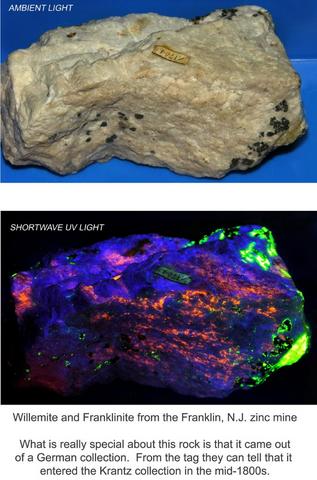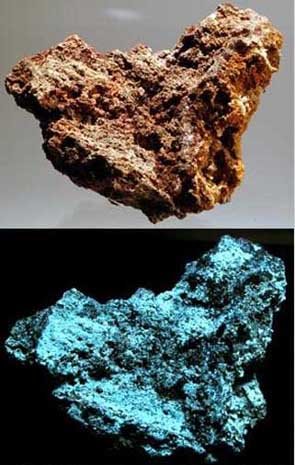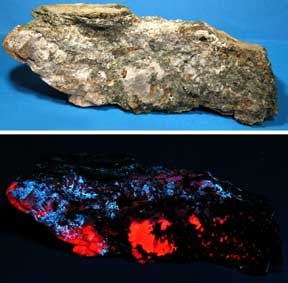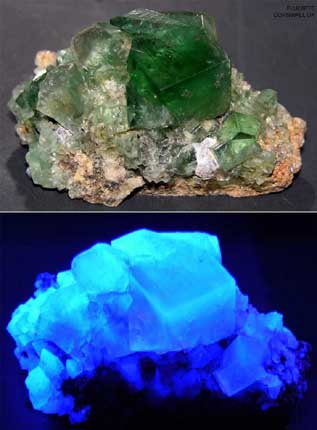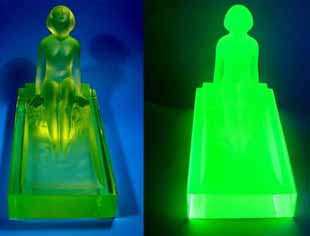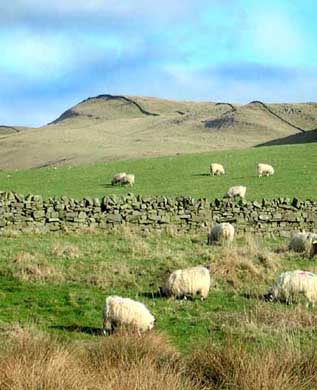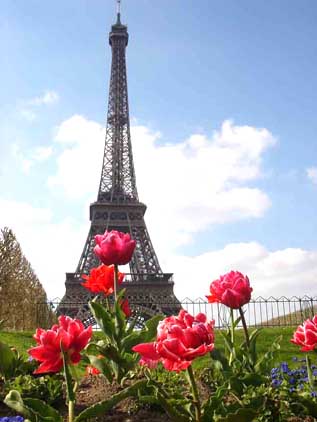Chalcedony
Chalcedony is silicon dioxide. It is a fibrous, translucent to opaque, compact microcrystalline variety of quartz that occurs in white, gray, and grayish-blue hues. Chalcedony is formed by silica-rich water percolating through cavities and fissures in volcanic rock. Chalcedony is a relatively porous material which can be easily dyed to alter or enhance the color.
According to the eminently respected MindDat.org, chalcedony was traditionally defined as a fibrous cryptocrystalline variety of Quartz, but more recently it has been shown that much Chalcedony is a mixture of Quartz and Moganite which is another silicon dioxide mineral. http://www.mindat.org/min-960.html
Onyx, agate, jasper, carnelian, chert, and petrified (agatized) wood are all varieties of chalcedony.
Many chalcedony “roses” contain trace amounts of the uranyl ion which make them fluoresce green when illuminated with short wave ultraviolet light. To hear the proper way to pronounce the word “chalcedony” go to: http://www.thefreedictionary.com/chalcedony
 Chalcedony is crystallographically identical to the quartz. Chalcedony has a hardness of 6-7 on the Mohs scale. The toughness of Chalcedony is Good. Chalcedony belongs to the Hexagonal or Trigonal crystal system with a Microcrystalline crystal habit. The specific gravity is 2.6 to 2.7 and chalcedony has a refractive index of 1.550 with a dull to waxy luster. Chalcedony is found all over the world and in all 50 states of America.
Chalcedony is crystallographically identical to the quartz. Chalcedony has a hardness of 6-7 on the Mohs scale. The toughness of Chalcedony is Good. Chalcedony belongs to the Hexagonal or Trigonal crystal system with a Microcrystalline crystal habit. The specific gravity is 2.6 to 2.7 and chalcedony has a refractive index of 1.550 with a dull to waxy luster. Chalcedony is found all over the world and in all 50 states of America.
Chalcedony was one of the first materials used by early man to form tools and arrowheads, due to its durability and abundance. Flint, which was used as a fire-starting tool, is a variety of chalcedony.
The name "Chalcedony" (Calcédoine French, Chalzedon, Kalzedon German, Piedra de luna Spanish or Italian) is derived from the ancient sea port of Khalkedon, at the crossroads of Europe and Asia in Constantinople which today is the Kadıköy district of Istanbul, Turkey.
Spanish or Italian) is derived from the ancient sea port of Khalkedon, at the crossroads of Europe and Asia in Constantinople which today is the Kadıköy district of Istanbul, Turkey.
As early as the Bronze Age chalcedony was in use in the Mediterranean region. Chalcedony seals have been recovered dating to ca.1800 BC. People living along the Central Asian trade routes used various forms of chalcedony including carnelian to carve intaglios and cameos. An intaglio is a negative (incised) image and is the opposite of a cameo.
Hot wax would not stick to chalcedony, so it was often used to make intaglio wax seal impressions. Many Roman era seal rings were made from carnelian or other varieties of chalcedony.
-
-
-
-
-
-
-
-
-
-
According to the eminently respected MindDat.org, chalcedony was traditionally defined as a fibrous cryptocrystalline variety of Quartz, but more recently it has been shown that much Chalcedony is a mixture of Quartz and Moganite which is another silicon dioxide mineral. http://www.mindat.org/min-960.html
Onyx, agate, jasper, carnelian, chert, and petrified (agatized) wood are all varieties of chalcedony.
Many chalcedony “roses” contain trace amounts of the uranyl ion which make them fluoresce green when illuminated with short wave ultraviolet light. To hear the proper way to pronounce the word “chalcedony” go to: http://www.thefreedictionary.com/chalcedony
 Chalcedony is crystallographically identical to the quartz. Chalcedony has a hardness of 6-7 on the Mohs scale. The toughness of Chalcedony is Good. Chalcedony belongs to the Hexagonal or Trigonal crystal system with a Microcrystalline crystal habit. The specific gravity is 2.6 to 2.7 and chalcedony has a refractive index of 1.550 with a dull to waxy luster. Chalcedony is found all over the world and in all 50 states of America.
Chalcedony is crystallographically identical to the quartz. Chalcedony has a hardness of 6-7 on the Mohs scale. The toughness of Chalcedony is Good. Chalcedony belongs to the Hexagonal or Trigonal crystal system with a Microcrystalline crystal habit. The specific gravity is 2.6 to 2.7 and chalcedony has a refractive index of 1.550 with a dull to waxy luster. Chalcedony is found all over the world and in all 50 states of America.Chalcedony was one of the first materials used by early man to form tools and arrowheads, due to its durability and abundance. Flint, which was used as a fire-starting tool, is a variety of chalcedony.
The name "Chalcedony" (Calcédoine French, Chalzedon, Kalzedon German, Piedra de luna
 Spanish or Italian) is derived from the ancient sea port of Khalkedon, at the crossroads of Europe and Asia in Constantinople which today is the Kadıköy district of Istanbul, Turkey.
Spanish or Italian) is derived from the ancient sea port of Khalkedon, at the crossroads of Europe and Asia in Constantinople which today is the Kadıköy district of Istanbul, Turkey.As early as the Bronze Age chalcedony was in use in the Mediterranean region. Chalcedony seals have been recovered dating to ca.1800 BC. People living along the Central Asian trade routes used various forms of chalcedony including carnelian to carve intaglios and cameos. An intaglio is a negative (incised) image and is the opposite of a cameo.
Hot wax would not stick to chalcedony, so it was often used to make intaglio wax seal impressions. Many Roman era seal rings were made from carnelian or other varieties of chalcedony.
-
-
-
-
-
-
-
-
-
-





